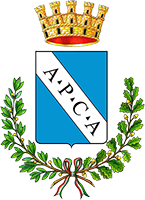
Piazza Guglielmo Marconi, known as “Platea Sanctae Mariae”, during the Medieval age, probably coincides with the ancient Platea Maior. The gate, with its two arches that lead into it (called Cubic Gate or Square Arch), marked the highest and nobler part of the town, the so-called Arce or Acropolis, typical of the Etruscan and Umbrian towns, that were usually fortified and represented the monumental entrance of the town. Of the original structure, only the internal arch survives (2nd – 1st century BC), the one that faces out on the square, made of big, squared travertine blocks. Originally, a monumental fountain leaned against the arch, then replaced with the church of Santa Maria di Porta, whose today only the doorway remains (at street number 2). The external arch, instead, is considered much more recent and it probably dates back to the Imperial age (1st – 2nd century AD). It has a round barrel vault, and it is decorated with marble inserts. Between the two arches, there is a barrel vault gallery, and, on the left side, we can see a painting representing the Virgin with Child made by an anonymous painter of the 15th century.
In later times, this spot had other names: during the Renaissance it was called Piazza Grande until the Unification of Italy when it was newly dedicated to King Victor Emanuel II. Then it was commonly called “Piazza della Posta” (Post Office Square), due to the ancient papal postal station hosted here since the 18th century: the square still conserves the paving stones separated by rows of terracotta bricks, typical of that period. The square was also briefly called Piazza Petrignani, because of the palace bearing the same name which rises here and stands out among the other buildings thanks to its high and imposing facade.
Town Crier’s Arcade, Nacci Palace, Cubic Gate and Petrignani Palace: in this square, some of the town’s most important buildings can be admired. On the short side to the left, the characteristic Town Crier’s Arcade raises. From its vantage stand, reachable through a double flight of stairs, the town crier, or Herald, made public announcements to the call of a trumpet. On the stairway, a column with a Doric capital stand, erected in 1479 in honour of Stefano Colonna, who committed the jurisdiction of the town of Penna in Teverina, an ancient feud that belonged to Colonna family, to the municipality of Amelia. An eighteen-century public clock is hosted on the top of the loggia.
Nacci palace, situated on the corner of Via del Duomo and Via Garibaldi, was originally built in 1342 by joining together three separate Medieval tower-dwellings, taking advantage of the 13th century market’s arched vaults as a support. The entrance is on the opposite side, in via Carleni, and it consists of a sculpted doorway with an inscription bearing the name of its former owner “Hippo Naccius”. The interior has a harmonious courtyard with an elegant stairway leading to the arcade, made up by finely carved columns and capitals.


